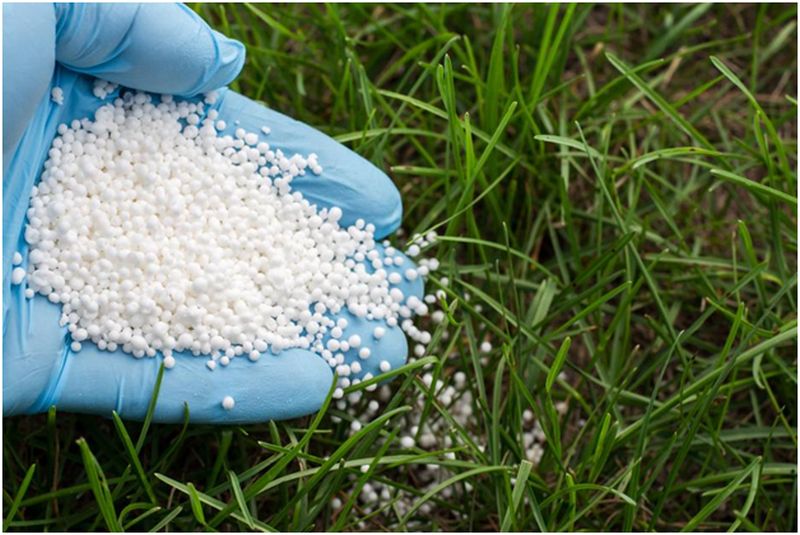Proper fertilization of the lawn will ensure even grass growth and reduce unwanted weeds or moss. By using mini granulated, we can be sure that it will not remain on the blades and get into the ground.
How and why should you fertilize your lawn?
Organic fertilizers, in addition to nutrients, provide organic matter that is very valuable for the soil, which is later transformed into humus, especially on lawns established on sandy soils that are poor in humus. They also contribute to improving the physical properties of the soil. The most valuable and easy to obtain is compost. It should be mature and free of weed seeds. It is spread in an even layer 0.5-1 cm thick in spring or at other times on a previously raked lawn. The compost is good to sift through a 1 cm mesh reef before application, which will facilitate spreading and even distribution.
Unhealthy lawns should be fertilized after the spring raking of the grass, before the first mowing. It is important that the lawn is dry. On wet turf, mineral fertilizers stick to the leaves, causing them to burn. The lawn can be fertilized with a multi-nutrient fertilizer, or with slow-release fertilizers. Lawns that are mowed and used intensively require very careful and frequent fertilization.
Throughout the growing season, the grass takes up the macro- and micronutrients necessary for life from the soil. It is recommended to use 2-4 kg of compound fertilizer per 100 m², and up to 8 kg when mowing intensively. It is best to divide the dose of fertilizer into three parts. The first dose is spread in spring, the second in summer (in June), and the last in early August.
For more information and gardening tips check this.
What fertilizer to choose for the lawn?
When fertilizing the lawn with nitrogen fertilizers, remember that the last dose of fertilizer is applied in September at a rate of no more than 1-2 kg per 100 m². Late application of nitrogen fertilizers results in more luxuriant growth and prolonged vegetation, which consequently promotes autumn and winter infestation of grasses by diseases and pests and may contribute to poor wintering of the lawn. There are multi-nutrient fertilizers on the market, designed exclusively for use on lawns, which should be applied 4-5 times a season.
It is more convenient to use long-acting fertilizers, which are applied once a season. It is also possible to carry out the first post-winter fertilization of the lawn with a compound fertilizer, at a rate of 2 kg per 100 m², and later every 4 weeks with ammonium nitrate at a rate of 1-2 kg per 100 m². After fertilizing, the lawn should be watered generously.
Loose fertilizers should be spread with special seeders, as they guarantee us an even and thorough sowing of the lawn without leaving empty spaces. When sowing fertilizers by hand, divide the dose of fertilizer into two equal parts and then sow them consecutively in two intersecting directions.
How does the Substral “100 days” Lawn fertilizer work?
When looking for the right long-acting fertilizer, we need to pay attention to an important issue – the size of the granules that we spread over the surface of the lawn. This is crucial because the penetration of the fertilizer into the ground and reducing the risk of remaining on the blades of grass and wasting the product.
Substral “100 Days” Lawn is a long-acting minigranulate that is much more efficient than regular granules. These tiny balls are uniform and small, so we are sure that they dissolve faster in the soil and provide nourishment to the grass – they do not remain on the blades.
In addition, it is a child- and pet-friendly – thanks to its penetration into the ground, without remaining on the grass, our baby or pet will not consume the granules. By emphasizing the absorption and nutrition of the soil, it ensures even fertilization over the entire area. There is no risk of the lawnmower pulling in the fertilizer – the mini granules fall deeper, near the surface of the ground.
Fertilizers for special tasks
If additional problems appear on the lawn, it is worth using a fertilizer that removes the cause and cares for the grass in depth:
- Moss occurring in parts of the lawn is troublesome to remove – apply a preparation with iron as soon as possible. Substral Lawn with Moss used in April, preferably at a temperature of 15 degrees Celsius will further inhibit the appearance of moss germs. Wanting to prevent the recurrence of moss, take care of the drainage of the substrate – it must not be too wet. Special shoes with spikes will improve the permeability of the soil.
- Wanting to strengthen the lawn and ensure the right density, it is worth using a starter fertilizer, which will help the growth of the grass at the establishment of the lawn, and will also help regeneration later. Substral “100 Days” Regenerator is a mini-fertilizer that is efficient and long-acting. When sowing grass seeds, Substral “100 days” for sowing will also be ideal, which accelerates growth and facilitates rooting of seeds.Article Submitted By Community Writer




